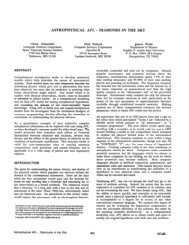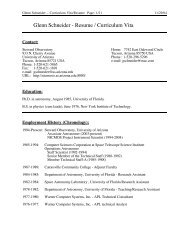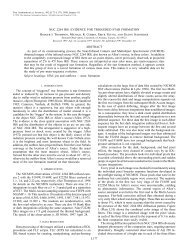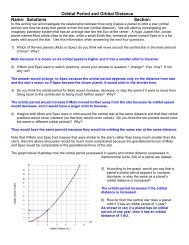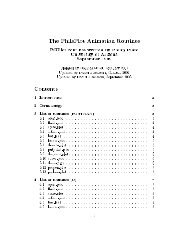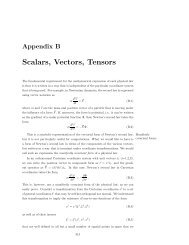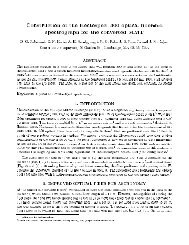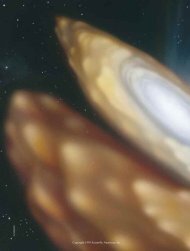Gathering light; the telescope - University of Arizona
Gathering light; the telescope - University of Arizona
Gathering light; the telescope - University of Arizona
Create successful ePaper yourself
Turn your PDF publications into a flip-book with our unique Google optimized e-Paper software.
2.1.Basic Principles<br />
Chapter 2: <strong>Ga<strong>the</strong>ring</strong> <strong>light</strong> - <strong>the</strong> <strong>telescope</strong><br />
Astronomy centers on <strong>the</strong> study <strong>of</strong> vanishingly faint signals, <strong>of</strong>ten from complex fields <strong>of</strong><br />
sources. Job number one is <strong>the</strong>refore to collect as much <strong>light</strong> as possible, with <strong>the</strong> highest<br />
possible angular resolution. So life is simple. We want to: 1.) build <strong>the</strong> largest <strong>telescope</strong><br />
we can afford (or can get someone else to buy for us), 2.) design it to be efficient and 3.)<br />
at <strong>the</strong> same time shield <strong>the</strong> signal from unwanted contamination, 4.) provide diffractionlimited<br />
images over as large an area in <strong>the</strong> image plane as we can cover with detectors,<br />
and 5.) adjust <strong>the</strong> final beam to match <strong>the</strong> signal optimally onto those detectors. Figure<br />
2.1 shows a basic <strong>telescope</strong> that we might use to achieve <strong>the</strong>se goals.<br />
Achieving<br />
condition 4.) is a<br />
very strong driver<br />
on <strong>telescope</strong><br />
design. The<br />
etendue is constant<br />
only for a beam<br />
passing through a<br />
perfect optical<br />
system. For such a<br />
system, <strong>the</strong> image<br />
Figure 2.1. Simple Prime-Focus Telescope<br />
FoTelescope primary mirror parameters.<br />
quality is limited by <strong>the</strong> wavelength <strong>of</strong> <strong>the</strong> <strong>light</strong> and <strong>the</strong> diffraction at <strong>the</strong> limiting<br />
aperture for <strong>the</strong> <strong>telescope</strong> (normally <strong>the</strong> edge <strong>of</strong> <strong>the</strong> primary mirror). Assuming that <strong>the</strong><br />
<strong>telescope</strong> primary is circular, <strong>the</strong> resulting image illumination is<br />
where m = (π r 0 θ / λ), r 0 is <strong>the</strong> radius<br />
<strong>of</strong> <strong>the</strong> <strong>telescope</strong> aperture (=D/2 in<br />
Figure 2.1), is <strong>the</strong> wavelength <strong>of</strong><br />
operation, and J 1 is a Bessel function<br />
<strong>of</strong> <strong>the</strong> first kind. The result is <strong>the</strong> wellknown<br />
Airy function (Figure 2.2),<br />
named after <strong>the</strong> British astronomer<br />
George Biddell Airy. We will illustrate<br />
a simple derivation later in this<br />
chapter.<br />
The first zero <strong>of</strong> <strong>the</strong> Bessel function<br />
occurs at m= 1.916, or for small θ, at θ Figure 2.2. The Airy Function<br />
1.22 λ / D. The classic Rayleigh<br />
Criterion states that two point sources <strong>of</strong> equal brightness can be distinguished only if<br />
<strong>the</strong>ir separation is > 1.22 /D; that is, <strong>the</strong> peak <strong>of</strong> one image is no closer than <strong>the</strong> first<br />
dark ring in <strong>the</strong> o<strong>the</strong>r. With modern image analysis techniques, this criterion can be
eadily surpassed. The full width at half maximum <strong>of</strong> <strong>the</strong> central image is about 1.03 /D<br />
for an unobscured aperture and becomes s<strong>light</strong>ly narrower if <strong>the</strong>re is a blockage in <strong>the</strong><br />
center <strong>of</strong> <strong>the</strong> aperture (e.g., a secondary mirror).<br />
Although we will emphasize a more ma<strong>the</strong>matical approach in this chapter, recall from<br />
<strong>the</strong> previous chapter that <strong>the</strong> diffraction pattern can be understood as a manifestation <strong>of</strong><br />
Fermat’s Principle. Where <strong>the</strong> ray path lengths are so nearly equal that <strong>the</strong>y interfere<br />
constructively, we get <strong>the</strong> central image. The first dark ring lies where <strong>the</strong> rays are out <strong>of</strong><br />
phase and interfere destructively, and <strong>the</strong><br />
remainder <strong>of</strong> <strong>the</strong> <strong>light</strong> and dark rings represent<br />
constructive and destructive interference at<br />
increasing path differences.<br />
Although <strong>the</strong> diffraction limit is <strong>the</strong> ideal, practical<br />
optics have a series <strong>of</strong> shortcomings, described as<br />
aberrations. There are three primary geometric<br />
aberrations:<br />
1. spherical, occurs when an <strong>of</strong>f-axis input ray is<br />
directed in front <strong>of</strong> or behind <strong>the</strong> image<br />
position for an on-axis input<br />
ray, with rays at <strong>the</strong> same <strong>of</strong>faxis<br />
angle crossing <strong>the</strong> image<br />
plane symmetrically<br />
distributed around <strong>the</strong> on-axis<br />
image. Spherical aberration<br />
tends to yield a blurred halo<br />
around an image (Figure 2.3).<br />
Figure 2.3. The most famous example<br />
<strong>of</strong> spherical aberration, <strong>the</strong> Hubble<br />
Space Telescope before various means<br />
were taken to correct <strong>the</strong> problem.<br />
A sphere forms a perfect Figure 2.4. The focusing properties <strong>of</strong> a spherical reflector.<br />
image <strong>of</strong> a point source<br />
located at <strong>the</strong> center <strong>of</strong> <strong>the</strong> sphere, with <strong>the</strong> image produced on top <strong>of</strong> <strong>the</strong> source.<br />
However, for a source at infinity, <strong>the</strong> distance, F, where <strong>the</strong> reflected ray crosses <strong>the</strong><br />
axis <strong>of</strong> <strong>the</strong> mirror is<br />
where R is <strong>the</strong> radius <strong>of</strong> curvature <strong>of</strong> <strong>the</strong> mirror and is <strong>the</strong><br />
angle <strong>of</strong> reflectance from <strong>the</strong> surface <strong>of</strong> <strong>the</strong> mirror. That is, <strong>the</strong><br />
reflected rays cross <strong>the</strong> mirror axis at smaller values <strong>of</strong> F <strong>the</strong><br />
far<strong>the</strong>r <strong>of</strong>f-axis <strong>the</strong>y impinge on <strong>the</strong> mirror. The result is<br />
shown in Figure 2.4; <strong>the</strong>re is no point along <strong>the</strong> optical axis<br />
with a well-formed image.<br />
2. coma occurs when input rays arriving at an angle from <strong>the</strong><br />
optical axis miss toward <strong>the</strong> same side <strong>of</strong> <strong>the</strong> on-axis image no<br />
matter where <strong>the</strong>y enter <strong>the</strong> <strong>telescope</strong> aperture, and with a<br />
Figure 2.5. Comatic<br />
image displayed to<br />
show interference.
progressive increase in image diameter with increasing distance from <strong>the</strong> center <strong>of</strong> <strong>the</strong><br />
field. Coma is axially symmetric in <strong>the</strong> sense that similar patterns are generated by<br />
input rays at <strong>the</strong> same <strong>of</strong>f axis angle at all azimuthal positions. Comatic images have<br />
characteristic fan or comet-shapes with<br />
<strong>the</strong> tail pointing away from <strong>the</strong> center <strong>of</strong><br />
<strong>the</strong> image plane (Figure 2.5).<br />
A paraboloidal reflector provides an<br />
example. The paraboloid by construction<br />
produces a perfect image <strong>of</strong> a point<br />
source on <strong>the</strong> axis <strong>of</strong> <strong>the</strong> mirror and at<br />
infinite distance. As shown in Figure 2.6,<br />
<strong>the</strong> focus for a ray that is <strong>of</strong>f-axis by <strong>the</strong><br />
angle is displaced from <strong>the</strong> axis <strong>of</strong> <strong>the</strong><br />
mirror by<br />
<br />
3. astigmatism (Figure 2.7) is a cylindrical<br />
wavefront distortion resulting from an<br />
optical system that has different focal<br />
planes for an <strong>of</strong>f-axis object in one<br />
direction from <strong>the</strong> optical axis <strong>of</strong> <strong>the</strong><br />
system compared with <strong>the</strong> orthogonal direction. It results in images that are elliptical<br />
on ei<strong>the</strong>r side <strong>of</strong> best-focus, with <strong>the</strong><br />
direction <strong>of</strong> <strong>the</strong> long axis <strong>of</strong> <strong>the</strong> ellipse<br />
changing by 90 degrees going from<br />
ahead to behind focus.<br />
Two o<strong>the</strong>r aberrations are less fundamental<br />
but in practical systems can degrade <strong>the</strong><br />
entendue:<br />
4. curvature <strong>of</strong> field, which occurs when<br />
<strong>the</strong> best images are not formed at a<br />
plane but instead on a surface that is<br />
convex or concave toward <strong>the</strong> <strong>telescope</strong><br />
entrance aperture (see Figure 2.8).<br />
Figure 2.6. Focusing properties <strong>of</strong> a<br />
paraboloidal mirror.<br />
5. distortion arises when <strong>the</strong> image scale<br />
changes over <strong>the</strong> focal plane; that is, if a<br />
set <strong>of</strong> point sources placed on a uniform<br />
grid is observed, <strong>the</strong>ir relative image<br />
positions are displaced from <strong>the</strong><br />
corresponding grid positions at <strong>the</strong> focal<br />
plane. Figure 2.9 illustrates symmetric<br />
Figure 2.7. Illustration <strong>of</strong> astigmatism (from<br />
Starizona). If we assume <strong>the</strong> astigmatism is<br />
due to an asymmetry in <strong>the</strong> optics, <strong>the</strong>n <strong>the</strong><br />
tangential plane contains both <strong>the</strong> object being<br />
imaged and <strong>the</strong> axis <strong>of</strong> symmetry, and <strong>the</strong><br />
sagittal plane is orthogonal to <strong>the</strong> tangential<br />
one.
forms <strong>of</strong> distortion, but this defect<br />
can occur in a variety <strong>of</strong> o<strong>the</strong>r forms,<br />
such as trapezoidal.<br />
Nei<strong>the</strong>r <strong>of</strong> <strong>the</strong>se latter two aberrations<br />
actually degrade <strong>the</strong> images <strong>the</strong>mselves.<br />
The effects <strong>of</strong> field curvature can be<br />
removed by suitable design <strong>of</strong> <strong>the</strong><br />
following optics, or by curving <strong>the</strong><br />
detector surface to match <strong>the</strong> curvature Figure 2.8. Curvature <strong>of</strong> field<br />
<strong>of</strong> field. Distortion can be removed by<br />
resampling <strong>the</strong> images and placing <strong>the</strong>m at <strong>the</strong> correct positions, based on a previous<br />
characterization <strong>of</strong> <strong>the</strong> distortion effects. Such resampling may degrade <strong>the</strong> images,<br />
particularly if <strong>the</strong>y are poorly sampled (e.g., <strong>the</strong> detectors are too large to return all <strong>the</strong><br />
information about <strong>the</strong> images) but need not if care is used both in <strong>the</strong> system design and<br />
<strong>the</strong> method to remove <strong>the</strong> distortion.<br />
Optical systems using lenses are also<br />
subject to:<br />
6. chromatic aberration, resulting<br />
when <strong>light</strong> <strong>of</strong> different colors is<br />
not brought to <strong>the</strong> same focus.<br />
A central aspect <strong>of</strong> optics design is Figure 2.9. Distortion.<br />
that aberrations introduced by an<br />
optical element can be compensated with a following element to improve <strong>the</strong> image<br />
quality in multi-element optical systems. For example, some high performance<br />
commercial camera lenses have up to 20 elements that all work toge<strong>the</strong>r to provide high<br />
quality images over a large field.<br />
In addition to <strong>the</strong>se aberrations, <strong>the</strong> <strong>telescope</strong> performance can be degraded by<br />
manufacturing errors that result in <strong>the</strong> optical elements not having <strong>the</strong> exact prescribed<br />
shapes, by distortions <strong>of</strong> <strong>the</strong> elements in <strong>the</strong>ir mountings, and by mis-alignments.<br />
Although <strong>the</strong>se latter effects are also sometimes termed aberrations, <strong>the</strong>y are <strong>of</strong> a<br />
different class from <strong>the</strong> six aberrations we have listed and we will avoid this terminology.<br />
In operation, <strong>the</strong> images can be fur<strong>the</strong>r degraded by atmospheric seeing, <strong>the</strong> disturbance<br />
<strong>of</strong> <strong>the</strong> wavefronts <strong>of</strong> <strong>the</strong> <strong>light</strong> from <strong>the</strong> source as <strong>the</strong>y pass through a turbulent atmosphere<br />
with refractive index variations due to temperature inhomogeneity. A rough<br />
approximation <strong>of</strong> <strong>the</strong> behavior is that <strong>the</strong>re are atmospheric bubbles <strong>of</strong> size r 0 = 5 – 15 cm<br />
with temperature variations <strong>of</strong> a few hundredths up to 1 o C, moving at wind velocities <strong>of</strong><br />
10 to 50 m/sec (r 0 is defined by <strong>the</strong> typical size effective at a wavelength <strong>of</strong> 0.5m and<br />
called <strong>the</strong> Fried parameter). The time scale for variations over a typical size <strong>of</strong> r 0 at <strong>the</strong><br />
<strong>telescope</strong> is <strong>the</strong>refore <strong>of</strong> order 10msec. For a <strong>telescope</strong> with aperture smaller than r 0 , <strong>the</strong><br />
effect is to cause <strong>the</strong> images formed by <strong>the</strong> <strong>telescope</strong> to move as <strong>the</strong> wavefronts are tilted
to various angles by <strong>the</strong> passage <strong>of</strong> warmer and cooler air bubbles. If <strong>the</strong> <strong>telescope</strong><br />
aperture is much larger than r 0 , many different r 0 -sized columns are sampled at once.<br />
Images taken over significantly longer than 10msec are called seeing-limited, and have<br />
typical sizes <strong>of</strong> /r 0 , derived similarly to equation (1.12) since <strong>the</strong> wavefront is preserved<br />
accurately only over a patch <strong>of</strong> diameter ~ r 0 . These images may be 0.5 to 1 arcsec in<br />
diameter, or larger under poor conditions. However, since <strong>the</strong> phase <strong>of</strong> <strong>the</strong> <strong>light</strong> varies<br />
quickly over each r 0 -diameter patch, a complex and variable interference pattern is<br />
formed at <strong>the</strong> focal plane due to <strong>the</strong> interference among <strong>the</strong>se different patches. A fast<br />
exposure (e.g., ~ 10msec) freezes this pattern and <strong>the</strong> image appears speckled, within <strong>the</strong><br />
overall envelope <strong>of</strong> <strong>the</strong> seeing limit. This behavior is strongly wavelength-dependent.<br />
Because <strong>the</strong> refractive index <strong>of</strong> air decreases with increasing wavelength, r 0 increases<br />
roughly as 6/5 , so, for example, <strong>the</strong> effect <strong>of</strong> seeing at 10m is largely image motion<br />
even with a 10-m <strong>telescope</strong>. These topics will be covered more extensively in Chapter 7.<br />
There are a number <strong>of</strong> ways to describe <strong>the</strong> imaging performance <strong>of</strong> a <strong>telescope</strong> or o<strong>the</strong>r<br />
optical system. The nature <strong>of</strong> <strong>the</strong> diffraction-limited image is a function <strong>of</strong> <strong>the</strong> <strong>telescope</strong><br />
configuration (shape <strong>of</strong> primary mirror, size <strong>of</strong> secondary mirror, etc.), so we define<br />
“perfect” imaging as that obtained for <strong>the</strong> given configuration and with all o<strong>the</strong>r aspects<br />
<strong>of</strong> <strong>the</strong> <strong>telescope</strong> performing perfectly. The ratio <strong>of</strong> <strong>the</strong> signal from <strong>the</strong> brightest point in<br />
this perfect image divided into <strong>the</strong> signal from <strong>the</strong> same point in <strong>the</strong> achieved image is <strong>the</strong><br />
Strehl ratio. We can also measure <strong>the</strong> ratio <strong>of</strong> <strong>the</strong> total energy in an image to <strong>the</strong> energy<br />
received through a given round aperture at <strong>the</strong> focal plane, a parameter called <strong>the</strong><br />
encircled energy. We can also describe <strong>the</strong> root-mean-square (rms) errors <strong>of</strong> <strong>the</strong> delivered<br />
wavefronts compared with those for <strong>the</strong> “perfect” image. There is no simple way to relate<br />
<strong>the</strong>se performance descriptors to one ano<strong>the</strong>r, since <strong>the</strong>y each depend on different aspects<br />
<strong>of</strong> <strong>the</strong> optical performance. However, roughly speaking, a <strong>telescope</strong> can be considered to<br />
be diffraction limited if <strong>the</strong> Strehl ratio is > 0.8 or <strong>the</strong> rms wavefront errors are < /14,<br />
where is <strong>the</strong> wavelength <strong>of</strong> observation. This relation is known as <strong>the</strong> Maréchal<br />
criterion. A useful approximate relation between <strong>the</strong> Strehl ratio, S, and <strong>the</strong> rms<br />
wavefront error, , is also an extended version <strong>of</strong> an approximation due to Maréchal:<br />
<br />
2.2.Telescope design<br />
We will discuss general <strong>telescope</strong> design in <strong>the</strong> context <strong>of</strong> optical <strong>telescope</strong>s in <strong>the</strong><br />
following two sections, and <strong>the</strong>n in Section 2.4 will expand <strong>the</strong> treatment to <strong>telescope</strong>s<br />
for o<strong>the</strong>r wavelength regimes. In general, <strong>telescope</strong>s require <strong>the</strong> use <strong>of</strong> combinations <strong>of</strong><br />
multiple optical elements. The basic formulae we will use for simple geometric optics can<br />
be found in Section 1.3 (in Chapter 1). For more, consult any optics text.<br />
However, all <strong>of</strong> <strong>the</strong>se relations are subsumed for modern <strong>telescope</strong> design into computer<br />
“ray-tracing” programs that follow multiple rays <strong>of</strong> <strong>light</strong> through a hypo<strong>the</strong>tical train <strong>of</strong><br />
optical elements, applying <strong>the</strong> laws <strong>of</strong> refraction and reflection at each surface, to<br />
produce a simulated image. The properties <strong>of</strong> this image can be optimized iteratively,<br />
with assistance from <strong>the</strong> program. These programs usually can also include diffraction to<br />
provide a physical optics output in addition to <strong>the</strong> geometric ray trace.
None<strong>the</strong>less, <strong>the</strong>re are basic parameters in a <strong>telescope</strong> and in o<strong>the</strong>r optical systems that<br />
you need to understand. We need to define some terms before discussing <strong>the</strong>m:<br />
1. A real image is where <strong>the</strong> <strong>light</strong> from an unresolved source is brought to its greatest<br />
concentration – putting a detector at <strong>the</strong> position <strong>of</strong> <strong>the</strong> real image will record <strong>the</strong><br />
source.<br />
2. A virtual image can be formed if <strong>the</strong> optics produce a bundle <strong>of</strong> <strong>light</strong> that appears to<br />
come from a real image but no such image has been formed – for example, a convex<br />
mirror may reflect <strong>light</strong> so it appears that <strong>the</strong>re is a real image behind <strong>the</strong> mirror.<br />
Except for very specialized applications, refractive <strong>telescope</strong>s using lenses for <strong>the</strong>ir<br />
primary <strong>light</strong> collectors are no longer employed in astronomy; in addition to chromatic<br />
aberration, large lenses are difficult to support without distortion and <strong>the</strong>y absorb some <strong>of</strong><br />
<strong>the</strong> <strong>light</strong> ra<strong>the</strong>r than delivering it to <strong>the</strong> image plane (in <strong>the</strong> infrared, virtually all <strong>the</strong> <strong>light</strong><br />
is absorbed). However, refractive elements are important in o<strong>the</strong>r aspects <strong>of</strong> advanced<br />
<strong>telescope</strong> design, to be discussed later.<br />
Reflecting <strong>telescope</strong>s are achromatic and are also efficient because <strong>the</strong>y can be provided<br />
with high efficiency mirror surfaces. From <strong>the</strong> radio to <strong>the</strong> near-ultraviolet, metal mirror<br />
surfaces provide reflection efficiencies > 90%, and usually even > 95%. At wavelengths<br />
shorter than ~ 0.15m, metals have poor reflection and multilayer stacks <strong>of</strong> dielectrics are<br />
used, but with efficiencies <strong>of</strong> only 50 – 70%. Significantly short <strong>of</strong> 0.01m (energy > 0.1<br />
keV), grazing incidence reflection can still be used for <strong>telescope</strong>s, but with significant<br />
changes in configuration as discussed in Section 2.4.4.<br />
Although modern computer-aided optical design would in principle allow a huge<br />
combination <strong>of</strong> two-mirror <strong>telescope</strong> systems, <strong>the</strong> traditional conic-section-based<br />
concepts already work very well. The ability <strong>of</strong> conic section mirrors to form images is<br />
easily described in terms <strong>of</strong> Fermat’s Principle. As <strong>the</strong> surface <strong>of</strong> a sphere is everywhere<br />
<strong>the</strong> same distance from its center, so a concave spherical mirror images an object onto<br />
itself when that object is placed at <strong>the</strong> center <strong>of</strong> curvature. An ellipse defines <strong>the</strong> surface<br />
that has a constant sum <strong>of</strong> <strong>the</strong> distances from one focus to ano<strong>the</strong>r, so an ellipsoid images<br />
an object at one focus at <strong>the</strong> position <strong>of</strong> its second focus. A parabola can be described as<br />
an ellipse with one focus moved to infinite distance, so a paraboloid images an object at<br />
large distant to its focus. A hyperbola is defined as <strong>the</strong> locus <strong>of</strong> points whose difference<br />
<strong>of</strong> distances from two foci is constant. Thus, a hyperboloid forms a perfect image <strong>of</strong> a<br />
virtual image.<br />
The basic <strong>telescope</strong> types based on <strong>the</strong> properties <strong>of</strong> <strong>the</strong>se conic sections are:<br />
1. A prime focus <strong>telescope</strong> (Figure 2.1) has a paraboloidal primary mirror and forms<br />
images directly at <strong>the</strong> mirror focus; since <strong>the</strong> images are in <strong>the</strong> center <strong>of</strong> <strong>the</strong><br />
incoming beam <strong>of</strong> <strong>light</strong>, this arrangement is inconvenient unless <strong>the</strong> <strong>telescope</strong> is<br />
so large that <strong>the</strong> detector receiving <strong>the</strong> <strong>light</strong> blocks a negligible portion <strong>of</strong> this<br />
beam
2. A Newtonian <strong>telescope</strong> (Figure 2.10) uses a flat mirror tilted at 45 o to bring <strong>the</strong><br />
focus to <strong>the</strong> side <strong>of</strong> <strong>the</strong> incoming beam <strong>of</strong> <strong>light</strong> where it is generally more<br />
conveniently accessed<br />
3. A Gregorian <strong>telescope</strong> brings <strong>the</strong> <strong>light</strong> from its paraboloidal primary mirror to a<br />
focus, and <strong>the</strong>n uses an ellipsoidal mirror beyond this focus to bring it to a second<br />
focus. Usually this <strong>light</strong> passes through a hole in <strong>the</strong> center <strong>of</strong> <strong>the</strong> primary and <strong>the</strong><br />
second focus is conveniently behind <strong>the</strong> primary and out <strong>of</strong> <strong>the</strong> incoming beam.<br />
4. A Cassegrain <strong>telescope</strong> intercepts <strong>the</strong> <strong>light</strong> from its paraboloidal primary ahead <strong>of</strong><br />
<strong>the</strong> focus with a convex hyperboloidal mirror. This mirror re-focuses <strong>the</strong> <strong>light</strong><br />
from <strong>the</strong> virtual image formed by <strong>the</strong> primary to a second focus, usually behind<br />
<strong>the</strong> primary mirror as in <strong>the</strong> Gregorian design.<br />
Assuming perfect<br />
manufacturing <strong>of</strong><br />
<strong>the</strong>ir optics and<br />
maintenance <strong>of</strong><br />
<strong>the</strong>ir alignment,<br />
all <strong>of</strong> <strong>the</strong>se<br />
<strong>telescope</strong> types<br />
are limited in<br />
image quality by<br />
<strong>the</strong> coma due to<br />
<strong>the</strong>ir paraboloidal<br />
primary mirrors.<br />
Some less obvious<br />
conic section<br />
combinations are<br />
<strong>the</strong> Dall-Kirkham,<br />
with an ellipsoidal<br />
primary and<br />
spherical<br />
secondary, and <strong>the</strong><br />
inverted Dall-<br />
Kirkham, with a<br />
spherical primary<br />
and ellipsoidal<br />
secondary. Both<br />
suffer from larger<br />
amounts <strong>of</strong> coma<br />
than for <strong>the</strong><br />
paraboloidprimary<br />
types, and<br />
hence <strong>the</strong>y are<br />
seldom used.<br />
Figure 2.10. The basic optical <strong>telescope</strong> types.
2.3.Matching Telescopes to Instruments<br />
2.3.1. Telescope Parameters<br />
To match <strong>the</strong> <strong>telescope</strong> output to an instrument, we need to describe <strong>the</strong> emergent beam<br />
<strong>of</strong> <strong>light</strong> in detail. During <strong>the</strong> process <strong>of</strong> designing an instrument, usually an optical model<br />
<strong>of</strong> <strong>the</strong> <strong>telescope</strong> is included in <strong>the</strong> ray trace <strong>of</strong> <strong>the</strong> instrument to be sure that <strong>the</strong> two work<br />
as expected toge<strong>the</strong>r. A convenient vocabulary to describe <strong>the</strong> general matching <strong>of</strong> <strong>the</strong><br />
two is based on <strong>the</strong> following terms:<br />
The focal length is measured by projecting <strong>the</strong> conical bundle <strong>of</strong> rays that arrives at <strong>the</strong><br />
focus back until its diameter matches <strong>the</strong> aperture <strong>of</strong> <strong>the</strong> <strong>telescope</strong>; <strong>the</strong> focal length is <strong>the</strong><br />
length <strong>of</strong> <strong>the</strong> resulting projected bundle <strong>of</strong> rays. See Figure 2.1 for <strong>the</strong> simplest example.<br />
This definition allows for <strong>the</strong> effects, for example, <strong>of</strong> secondary mirrors in modifying <strong>the</strong><br />
properties <strong>of</strong> <strong>the</strong> ray bundle produced by <strong>the</strong> primary mirror.<br />
The f-number <strong>of</strong> <strong>the</strong> <strong>telescope</strong> is <strong>the</strong> diameter <strong>of</strong> <strong>the</strong> incoming ray bundle, i.e. <strong>the</strong><br />
<strong>telescope</strong> aperture, divided into <strong>the</strong> focal length, f/D in Figure 2.1. This term is also used<br />
as a general description <strong>of</strong> <strong>the</strong> angle <strong>of</strong> convergence <strong>of</strong> a beam <strong>of</strong> <strong>light</strong>, in which case it is<br />
<strong>the</strong> diameter <strong>of</strong> <strong>the</strong> beam at some distance from its focus, divided into this distance. The<br />
f-number can also be expressed as 0.5 cotan (θ), where θ is <strong>the</strong> beam half-angle. Beams<br />
with large f-numbers are “slow” while those with small ones are “fast.”<br />
Equation (1.11) can be used to determine <strong>the</strong> f-number <strong>of</strong> <strong>the</strong> beam at <strong>the</strong> focus <strong>of</strong> a<br />
<strong>telescope</strong>, given <strong>the</strong> desired mapping <strong>of</strong> <strong>the</strong> size <strong>of</strong> a detector element into its resolution<br />
on <strong>the</strong> sky. From equation (1.11), we can match to any detector area by adjusting <strong>the</strong><br />
optics to shape <strong>the</strong> beam to an appropriate solid angle. Simplifying to a round <strong>telescope</strong><br />
aperture <strong>of</strong> diameter D and a detector <strong>of</strong> diameter d,<br />
D d<br />
in<br />
out<br />
Thus, if <strong>the</strong> detector element is 10m = 1 X 10 -5 m on a side and we want it to map to 0.1<br />
arcsec = 4.85 X 10 -7 rad on <strong>the</strong> sky on a 10-m aperture <strong>telescope</strong>, we have<br />
7<br />
5<br />
10m<br />
4.8510<br />
rad 110<br />
m<br />
out<br />
Solving for θ out , <strong>the</strong> f-number <strong>of</strong> <strong>the</strong> beam into <strong>the</strong> detector is 1.0, a very fast beam<br />
indeed. This calculation previews an issue to be discussed in more detail later, that <strong>of</strong><br />
matching <strong>the</strong> outputs <strong>of</strong> large <strong>telescope</strong>s onto modern detector arrays with <strong>the</strong>ir relatively<br />
small pixels.<br />
The plate scale is <strong>the</strong> translation from physical units, e.g. mm, to angular ones, e.g.<br />
arcsec, at <strong>the</strong> <strong>telescope</strong> focal plane. As for <strong>the</strong> derivation <strong>of</strong> <strong>the</strong> thin lens formula, we can<br />
determine <strong>the</strong> plate scale by making use <strong>of</strong> <strong>the</strong> fact that any ray passing through <strong>telescope</strong><br />
on <strong>the</strong> optical axis <strong>of</strong> its equivalent single lens is not deflected. Thus, if we define <strong>the</strong><br />
magnification <strong>of</strong> <strong>the</strong> <strong>telescope</strong>, m, to be <strong>the</strong> ratio <strong>of</strong> <strong>the</strong> f number delivered to <strong>the</strong> focal<br />
plane to <strong>the</strong> primary mirror f number, <strong>the</strong>n <strong>the</strong> equivalent focal length <strong>of</strong> <strong>the</strong> <strong>telescope</strong> is<br />
and <strong>the</strong> angle on <strong>the</strong> sky corresponding to a distance b at <strong>the</strong> focal plane is
The field <strong>of</strong> view (FOV) is <strong>the</strong> total angle on <strong>the</strong> sky that can be imaged by <strong>the</strong> <strong>telescope</strong>.<br />
It might be limited by <strong>the</strong> <strong>telescope</strong> optics and baffles, or by <strong>the</strong> dimensions <strong>of</strong> <strong>the</strong><br />
detector (or acceptance angle <strong>of</strong> an instrument).<br />
A stop is a baffle or o<strong>the</strong>r construction (e.g., <strong>the</strong> edge <strong>of</strong> a mirror) that limits <strong>the</strong> bundle<br />
<strong>of</strong> <strong>light</strong> that can pass through it. Two examples are given below, but stops can be used for<br />
o<strong>the</strong>r purposes such as to eliminate any stray <strong>light</strong> from <strong>the</strong> area <strong>of</strong> <strong>the</strong> beam blocked by<br />
<strong>the</strong> secondary mirror and o<strong>the</strong>r structures in front <strong>of</strong> <strong>the</strong> primary mirror.<br />
The aperture stop limits <strong>the</strong> diameter <strong>of</strong> <strong>the</strong> incoming ray bundle from <strong>the</strong> object. For a<br />
<strong>telescope</strong>, it is typically <strong>the</strong> edge <strong>of</strong> <strong>the</strong> primary mirror.<br />
A field stop limits <strong>the</strong> range <strong>of</strong> angles a <strong>telescope</strong> can accept, that is, it is <strong>the</strong> limit on <strong>the</strong><br />
<strong>telescope</strong> field <strong>of</strong> view.<br />
A pupil is an image <strong>of</strong> a stop. An entrance pupil is an image <strong>of</strong> <strong>the</strong> aperture stop formed<br />
by optics ahead <strong>of</strong> <strong>the</strong> stop (not typically encountered with <strong>telescope</strong>s, but can be used<br />
with o<strong>the</strong>r types <strong>of</strong> optics such as camera lenses or instruments mounted on a <strong>telescope</strong>).<br />
An exit pupil is an image <strong>of</strong> <strong>the</strong> aperture stop formed by optics behind <strong>the</strong> stop. For<br />
example, <strong>the</strong> secondary mirror <strong>of</strong> a Cassegrain (or Gregorian) <strong>telescope</strong> forms an image<br />
<strong>of</strong> <strong>the</strong> aperture stop and hence determines <strong>the</strong> exit pupil <strong>of</strong> <strong>the</strong> <strong>telescope</strong>. The exit pupil is<br />
<strong>of</strong>ten re-imaged within an instrument because it has unique properties for performing a<br />
number <strong>of</strong> optical functions.<br />
2.3.2. MTF/OTF<br />
The image formed by a <strong>telescope</strong><br />
departs from <strong>the</strong> ideal for<br />
diffraction by a circular aperture<br />
for many reasons, such as: 1.)<br />
non-circular primary mirrors; 2.)<br />
aberrations in <strong>the</strong> <strong>telescope</strong><br />
optics; and 3.) manufacturing<br />
errors. In addition, we need a<br />
convenient way to understand <strong>the</strong><br />
combined imaging properties <strong>of</strong><br />
<strong>the</strong> <strong>telescope</strong> plus instrumentation<br />
being used with it.<br />
The modulation transfer function,<br />
or MTF makes use <strong>of</strong> <strong>the</strong><br />
properties <strong>of</strong> Fourier transforms<br />
to provide <strong>the</strong> desired general<br />
description <strong>of</strong> <strong>the</strong> imaging<br />
Figure 2.11. Modulation <strong>of</strong> a signal – (a) input and (b) output.
properties <strong>of</strong> an optical system. It falls short <strong>of</strong> a complete description <strong>of</strong> <strong>the</strong>se properties<br />
because it does not include phase information; <strong>the</strong> optical transfer function (OTF) is <strong>the</strong><br />
MTF times <strong>the</strong> phase transfer function. However, <strong>the</strong> MTF is more convenient to<br />
manipulate and is an adequate description for a majority <strong>of</strong> applications.<br />
To illustrate <strong>the</strong> meaning <strong>of</strong> <strong>the</strong> MTF, imagine that an array <strong>of</strong> detectors is exposed to a<br />
sinusoidal input signal <strong>of</strong> period P and amplitude F(x),<br />
where f = 1/P is <strong>the</strong> spatial frequency, x is <strong>the</strong> distance along one axis <strong>of</strong> <strong>the</strong> array, a 0 is<br />
<strong>the</strong> mean height (above zero) <strong>of</strong> <strong>the</strong> pattern, and a 1 is its amplitude. These terms are<br />
indicated in Figure 2.11a. The modulation <strong>of</strong> this signal is defined as<br />
where F max and F min are <strong>the</strong> maximum and minimum values <strong>of</strong> F(x). We now imagine<br />
that we use a <strong>telescope</strong> to image a nominally identical sinusoidal pattern onto <strong>the</strong> detector<br />
array. The resulting output can be represented by<br />
where x and f are <strong>the</strong> same as in equation above, and b 0 and b 1 (f) are analogous to a 0 and<br />
a 1 (Figure 2.11b). The <strong>telescope</strong><br />
will have limited ability to image<br />
very fine details in <strong>the</strong> sinusoidal<br />
pattern. In terms <strong>of</strong> <strong>the</strong> Fourier<br />
transform <strong>of</strong> <strong>the</strong> image, this<br />
degradation <strong>of</strong> <strong>the</strong> image is<br />
described as an attenuation <strong>of</strong> <strong>the</strong><br />
high spatial frequencies in <strong>the</strong><br />
image. The dependence <strong>of</strong> <strong>the</strong><br />
signal amplitude, b 1 , on <strong>the</strong> spatial<br />
frequency, f, shows <strong>the</strong> drop in<br />
response as <strong>the</strong> spatial frequency<br />
grows (i.e., <strong>the</strong> loss <strong>of</strong> fine detail in<br />
<strong>the</strong> image). The modulation in <strong>the</strong><br />
image will be<br />
The modulation transfer factor is<br />
Figure 2.12. The MTF (schematically) corresponding to<br />
<strong>the</strong> function in Figure 2.11b.<br />
A separate value <strong>of</strong> <strong>the</strong> MT will apply at each spatial frequency; Figure 2.11a illustrates<br />
an input signal that contains a range <strong>of</strong> spatial frequencies, and Figure 2.11b shows a<br />
corresponding output in which <strong>the</strong> modulation decreases with increasing spatial<br />
frequency. This frequency dependence <strong>of</strong> <strong>the</strong> MT is expressed in <strong>the</strong> modulation transfer
function (MTF). Figure 2.12 shows <strong>the</strong> MTF corresponding to <strong>the</strong> response <strong>of</strong> Figure<br />
2.11b.<br />
In principle, <strong>the</strong> MTF provides a virtually complete specification <strong>of</strong> <strong>the</strong> imaging<br />
properties <strong>of</strong> an optical system. Computationally, <strong>the</strong> MTF can be determined by taking<br />
<strong>the</strong> absolute value <strong>of</strong> <strong>the</strong> Fourier transform, F(u), <strong>of</strong> <strong>the</strong> image <strong>of</strong> a perfect point source<br />
(this image is called <strong>the</strong> point spread function). Fourier transformation is <strong>the</strong> general<br />
ma<strong>the</strong>matical technique used to determine <strong>the</strong> frequency components <strong>of</strong> a function f(x)<br />
(see, for example, Press et al. 1986; Bracewell 2000). F(u) is defined as<br />
with inverse<br />
Only a relatively small number <strong>of</strong> functions have Fourier transforms that are easy to<br />
manipulate. With <strong>the</strong> use <strong>of</strong> computers, however, Fourier transformation is a powerful<br />
and very general technique. The Fourier transform can be generalized in a<br />
straightforward way to two dimensions, but for <strong>the</strong> sake <strong>of</strong> simplicity we will not do so<br />
here. The absolute value <strong>of</strong> <strong>the</strong> transform is<br />
where F*(u) is <strong>the</strong> complex conjugate <strong>of</strong> F(u); it is obtained by reversing <strong>the</strong> sign <strong>of</strong> all<br />
imaginary terms in F(u).<br />
The point spread function is<br />
<strong>the</strong> image a system forms<br />
<strong>of</strong> a perfectly sharp point<br />
input image. If f(x)<br />
represents <strong>the</strong> point spread<br />
function, |F(u)|/|F(0)| is <strong>the</strong><br />
MTF <strong>of</strong> <strong>the</strong> system, with u<br />
<strong>the</strong> spatial frequency. This<br />
formulation holds because a<br />
sharp impulse, represented<br />
ma<strong>the</strong>matically by a <br />
function, contains all<br />
frequencies equally (that is,<br />
its Fourier transform is a<br />
constant). Hence <strong>the</strong><br />
Fourier transform <strong>of</strong> <strong>the</strong><br />
image formed from an input<br />
sharp impulse gives <strong>the</strong><br />
spatial frequency response<br />
<strong>of</strong> <strong>the</strong> optical system.<br />
Figure 2.13. MTF <strong>of</strong> a round <strong>telescope</strong> with no central obscuration.<br />
Spatial frequencies are in units <strong>of</strong> D/λ.
The MTF is normalized to unity at spatial frequency 0 by this definition. As emphasized<br />
in Figure 2.12, <strong>the</strong> response at zero frequency cannot be measured directly but must be<br />
extrapolated from higher frequencies.<br />
The image <strong>of</strong> an entire linear optical system is <strong>the</strong> convolution <strong>of</strong> <strong>the</strong> images from each<br />
element. By <strong>the</strong> "convolution <strong>the</strong>orem", its MTF can be determined by multiplying<br />
toge<strong>the</strong>r <strong>the</strong> MTFs <strong>of</strong> its constituent elements, and <strong>the</strong> resulting image is determined by<br />
inverse transforming <strong>the</strong> resulting MTF. The multiplication occurs on a frequency by<br />
frequency basis, that is, if <strong>the</strong> first system has MTF 1 (f) and <strong>the</strong> second MTF 2 (f), <strong>the</strong><br />
combined system has MTF(f) = MTF 1 (f) MTF 2 (f). The overall resolution capability <strong>of</strong><br />
complex optical systems can be more easily determined in this way than by brute force<br />
image convolution.<br />
We now show <strong>the</strong> power <strong>of</strong> <strong>the</strong> MTF by illustrating <strong>the</strong> calculation <strong>of</strong> <strong>the</strong> Airy function.<br />
We define <strong>the</strong> box function in two dimensions as<br />
Thus, we describe a round aperture <strong>of</strong> radius r 0 functionally as<br />
The corresponding MTF is<br />
<br />
(see Figure 2.13). The intensity in <strong>the</strong> image is<br />
<br />
<br />
This result is identical to equation (2.1) describing <strong>the</strong> diffraction-limited image.<br />
2.4. Telescope Optimization<br />
2.4.1. Wide Field<br />
The classic <strong>telescope</strong> designs all rely<br />
on <strong>the</strong> imaging properties <strong>of</strong> a<br />
paraboloid, with secondary mirrors to<br />
relay <strong>the</strong> image formed by <strong>the</strong> primary<br />
mirror to a second focus. What would<br />
happen if no image were demanded <strong>of</strong><br />
<strong>the</strong> primary, but <strong>the</strong> conic sections on<br />
<strong>the</strong> primary and secondary mirrors<br />
were selected to provide optimum<br />
imaging as a unit One answer to this<br />
Figure 2.14. Three-mirror wide field <strong>telescope</strong> design<br />
after Baker and Paul.<br />
question is <strong>the</strong> Ritchey-Cretién <strong>telescope</strong>. In this design, a suitable selection <strong>of</strong> hyperbolic<br />
primary and secondary toge<strong>the</strong>r can compensate for <strong>the</strong> spherical and comatic aberrations
(to third order in an expansion in angle <strong>of</strong> incidence) and provide large fields, up to an<br />
outer boundary where astigmatism becomes objectionable. An alternative, <strong>the</strong> aplanatic<br />
Gregorian <strong>telescope</strong>, has ellipsoidal primary and secondary, and similar wide-field<br />
performance.<br />
Still larger fields can be achieved by adding optics specifically to compensate for <strong>the</strong><br />
aberrations. A classic example is <strong>the</strong> Schmidt camera, which has a full-aperture refractive<br />
corrector in front <strong>of</strong> its spherical primary mirror. The corrector imposes spherical<br />
aberration on <strong>the</strong> input beam in <strong>the</strong> same amount but opposite sign as <strong>the</strong> aberration <strong>of</strong><br />
<strong>the</strong> primary, producing well-corrected images over a large field. The Maksutov and<br />
Schmidt-Cassegrain designs achieve similar ends with correctors <strong>of</strong> different types.<br />
However, refractive elements larger than 1 – 1.5m in diameter become prohibitively<br />
difficult to mount and maintain in figure. A variety <strong>of</strong> designs for correctors near <strong>the</strong><br />
focal plane are also possible (e.g., Epps & Fabricant 1997). A simple version invented by<br />
F. E. Ross uses two lenses, one positive and <strong>the</strong> o<strong>the</strong>r negative to cancel each o<strong>the</strong>r in<br />
optical power but to correct coma. Wynne (1974) proposed a more powerful device with<br />
three lenses, <strong>of</strong> positive-negative-positive power and all with spherical surfaces. A<br />
Wynne corrector can correct for chromatic aberration, field curvature, spherical<br />
aberration, coma, and astigmatism. Such approaches are used with all <strong>the</strong> wide field<br />
cameras on 10-m-class <strong>telescope</strong>s. These optical trains not only correct <strong>the</strong> field but also<br />
can provide for spectrally active components, such as compensators for <strong>the</strong> dispersion <strong>of</strong><br />
<strong>the</strong> atmosphere that allow high quality images to be obtained at <strong>of</strong>f-zenith pointings and<br />
over broad spectral bands (e.g., Fabricant et al. 2004).<br />
Even wider fields can be obtained by adding large reflective elements to <strong>the</strong> optical train<br />
<strong>of</strong> <strong>the</strong> <strong>telescope</strong>, an approach pioneered by Baker and Paul, see Figure 2.14. The basic<br />
concept is that, by making <strong>the</strong> second mirror spherical, <strong>the</strong> <strong>light</strong> is deviated in a similar<br />
way as it would be by <strong>the</strong> corrector lens <strong>of</strong> a Schmidt camera. The third, spherical, mirror<br />
brings <strong>the</strong> <strong>light</strong> to <strong>the</strong> <strong>telescope</strong> focal plane over a large field. The Baker-Paul concept is a<br />
very powerful one and underlies <strong>the</strong> large field <strong>of</strong> <strong>the</strong> Large Synoptic Survey Telescope<br />
(LSST). . With three or more mirror surfaces to play with, optical designers can achieve a<br />
high degree <strong>of</strong> image correction in o<strong>the</strong>r ways also. For example, a three-mirror<br />
anastigmat is corrected simultaneously for spherical aberration, coma, and astigmatism.<br />
2.4.2. Infrared<br />
The basic optical considerations for groundbased <strong>telescope</strong>s apply in <strong>the</strong> infrared as well.<br />
However, in <strong>the</strong> <strong>the</strong>rmal infrared (wavelengths longer than about 2m), <strong>the</strong> emission <strong>of</strong><br />
<strong>the</strong> <strong>telescope</strong> is <strong>the</strong> dominant signal on <strong>the</strong> detectors and needs to be minimized to<br />
maximize <strong>the</strong> achievable signal to noise on astronomical sources. It is not possible to cool<br />
any <strong>of</strong> <strong>the</strong> exposed parts <strong>of</strong> <strong>the</strong> <strong>telescope</strong> because <strong>of</strong> atmospheric condensation. However,<br />
<strong>the</strong> sky is both colder and <strong>of</strong> lower emissivity (since one looks in bands where it is<br />
transparent) than <strong>the</strong> structure <strong>of</strong> <strong>the</strong> <strong>telescope</strong>. Therefore, one minimizes <strong>the</strong> structure<br />
visible to <strong>the</strong> detector by using a modest sized secondary mirror (e.g., f/15), matching it<br />
with a small central hole in <strong>the</strong> primary mirror, keeping <strong>the</strong> secondary supports and o<strong>the</strong>r
structures in <strong>the</strong> beam with thin cross-sections, and most importantly, removing <strong>the</strong><br />
baffles. The instruments operate at cryogenic temperatures; by forming a pupil within<br />
<strong>the</strong>ir optical trains and putting a tight stop at it, <strong>the</strong> view <strong>of</strong> warm structures can be<br />
minimized without losing <strong>light</strong> from <strong>the</strong> astronomical sources. However, <strong>the</strong> pupil image<br />
generally is not perfectly sharp and <strong>the</strong> stop is <strong>the</strong>refore made a bit oversized. To avoid<br />
excess emission from <strong>the</strong> area around <strong>the</strong> primary mirror entering <strong>the</strong> system, <strong>of</strong>ten <strong>the</strong><br />
secondary mirror is made s<strong>light</strong>ly undersized, so its edge becomes <strong>the</strong> aperture stop <strong>of</strong> <strong>the</strong><br />
<strong>telescope</strong>. Only emission from <strong>the</strong> sky enters <strong>the</strong> instrument over <strong>the</strong> edge <strong>of</strong> <strong>the</strong><br />
secondary, and in high-quality infrared atmospheric windows <strong>the</strong> sky is more than an<br />
order <strong>of</strong> magnitude less emissive than <strong>the</strong> primary mirror cell would be.<br />
The emissivity <strong>of</strong> <strong>the</strong> <strong>telescope</strong> mirrors needs to be kept low. If <strong>the</strong> <strong>telescope</strong> uses<br />
conventional aluminum coatings, <strong>the</strong>y must be kept very clean. Better performance can<br />
be obtained with silver or gold coatings. Obviously, it is also important to avoid<br />
additional warm mirrors in <strong>the</strong> optical train o<strong>the</strong>r than <strong>the</strong> primary and secondary.<br />
Therefore, <strong>the</strong> secondary mirror is called upon to perform a number <strong>of</strong> functions besides<br />
helping form an image. Because <strong>of</strong> <strong>the</strong> variability <strong>of</strong> <strong>the</strong> atmospheric emission, it is<br />
desirable to compare <strong>the</strong> image containing <strong>the</strong> source with an image <strong>of</strong> adjacent sky<br />
rapidly, and an articulated secondary can do this in a fraction <strong>of</strong> a second if desired.<br />
Modulating <strong>the</strong> signal with <strong>the</strong> secondary mirror has <strong>the</strong> important advantage that <strong>the</strong><br />
beam passes through nearly <strong>the</strong> identical column <strong>of</strong> air as it traverses <strong>the</strong> <strong>telescope</strong> (and<br />
even from high into <strong>the</strong> atmosphere), so any fluctuations in <strong>the</strong> infrared emission along<br />
this column are common to both mirror positions. A suitably designed secondary mirror<br />
can also improve <strong>the</strong> imaging, ei<strong>the</strong>r by compensating for image motion or even<br />
correcting <strong>the</strong> wavefront errors imposed by <strong>the</strong> atmosphere (see Chapter 7).<br />
The ultimate solution to <strong>the</strong>se issues is to place <strong>the</strong> infrared <strong>telescope</strong> in space, where it<br />
can be cooled sufficiently that it no longer dominates <strong>the</strong> signals. Throughout <strong>the</strong> <strong>the</strong>rmal<br />
infrared, <strong>the</strong> foreground signals can be reduced by a factor <strong>of</strong> a million or more in space<br />
compared with <strong>the</strong> ground, and hence phenomenally greater sensitivity can be achieved.<br />
Obviously, space also <strong>of</strong>fers <strong>the</strong> advantage <strong>of</strong> being above <strong>the</strong> atmosphere and hence free<br />
<strong>of</strong> atmospheric absorption, so <strong>the</strong> entire infrared range is accessible for observation. The<br />
price <strong>of</strong> operation in space includes not only cost, but restrictions on <strong>the</strong> maximum<br />
aperture (being mitigated with JWST), and <strong>the</strong> inability to change instruments or even to<br />
include all <strong>the</strong> instrument types desired. None<strong>the</strong>less, astronomy has benefited from a<br />
series <strong>of</strong> very successful cryogenic <strong>telescope</strong>s in space – <strong>the</strong> Infrared Astronomy Satellite<br />
(IRAS), <strong>the</strong> Infrared Space Observatory (ISO), <strong>the</strong> Spitzer Telescope, Akari, <strong>the</strong> Cosmic<br />
Background Explorer (COBE), and <strong>the</strong> Wide-Field Infrared Survey Explorer (WISE), to<br />
name some examples.<br />
2.4.3. Radio<br />
Radio <strong>telescope</strong>s are typically <strong>of</strong> conventional parabolic-primary-mirror, prime-focus<br />
design. The apertures are very large, so <strong>the</strong> blockage <strong>of</strong> <strong>the</strong> beam by <strong>the</strong> receivers at <strong>the</strong><br />
prime focus is insignificant. The primary mirrors have short focal lengths, f-ratios ~ 0.5,<br />
to keep <strong>the</strong> <strong>telescope</strong> compact and help provide a rigid structure. Sometimes <strong>the</strong> entire
<strong>telescope</strong> is designed in a way that <strong>the</strong> flexure as it is pointed in different directions<br />
occurs in a way that preserves <strong>the</strong> figure <strong>of</strong> <strong>the</strong> primary – <strong>the</strong>se designs are described as<br />
deforming homologously. For example, <strong>the</strong> 100-m aperture Effelsberg Telescope flexes<br />
by up to 6cm as it is pointed to different elevations, but maintains its paraboloidal figure<br />
to an accuracy <strong>of</strong> ~ 4mm.<br />
Telescopes for <strong>the</strong> mm- and sub-mm wave regimes are generally smaller and usually are<br />
built in a Cassegrain configuration, <strong>of</strong>ten with secondary mirrors that can be chopped or<br />
nutated over small angles to help<br />
compensate for background<br />
emission. They can be<br />
considered to be intermediate in<br />
design between longerwavelength<br />
radio <strong>telescope</strong>s and<br />
infrared <strong>telescope</strong>s. Ano<strong>the</strong>r<br />
exception to <strong>the</strong> general design<br />
trend is <strong>the</strong> Arecibo <strong>telescope</strong>,<br />
which has a spherical primary to<br />
allow steering <strong>the</strong> beam in<br />
different directions while <strong>the</strong><br />
primary is fixed. The spherical<br />
aberration is corrected by optics<br />
near <strong>the</strong> prime focus <strong>of</strong> <strong>the</strong><br />
<strong>telescope</strong> in this case.<br />
Radio receivers are uniformly <strong>of</strong><br />
coherent detector design; only in<br />
<strong>the</strong> mm- and sub-mm realms are<br />
bolometers used for continuum<br />
measurements and lowresolution<br />
spectroscopy. The<br />
operation <strong>of</strong> <strong>the</strong>se devices will Figure 2.15. The Byrd Green Bank Telescope.<br />
be described in more detail in<br />
Chapter 8. For this discussion, we need to understand that all such receivers are limited<br />
by <strong>the</strong> antenna <strong>the</strong>orem, which states that <strong>the</strong>y are sensitive only to <strong>the</strong> central peak <strong>of</strong> <strong>the</strong><br />
diffraction pattern <strong>of</strong> <strong>the</strong> <strong>telescope</strong>, and to only a single polarization.<br />
This behavior modifies how <strong>the</strong> imaging properties <strong>of</strong> <strong>the</strong> <strong>telescope</strong> are described. The<br />
primary measure <strong>of</strong> <strong>the</strong> quality <strong>of</strong> <strong>the</strong> <strong>telescope</strong> optics is beam efficiency, <strong>the</strong> ratio <strong>of</strong> <strong>the</strong><br />
power from a point source in <strong>the</strong> central peak <strong>of</strong> <strong>the</strong> image to <strong>the</strong> power in <strong>the</strong> entire<br />
image. The diffraction rings <strong>of</strong> <strong>the</strong> Airy pattern appear to radio astronomers as potential<br />
regions <strong>of</strong> unwanted sensitivity to sources away from <strong>the</strong> one at which <strong>the</strong> <strong>telescope</strong> is<br />
pointed. This issue is significant because <strong>of</strong> <strong>the</strong> relatively low angular resolution and high<br />
sensitivity <strong>of</strong> single-dish radio <strong>telescope</strong>s (as opposed to interferometers, see Chapter 9).<br />
The sensitive regions <strong>of</strong> <strong>the</strong> <strong>telescope</strong> beam outside <strong>the</strong> main Airy peak are called<br />
sidelobes. Additional sidelobes are produced by imperfections in <strong>the</strong> mirror surface. A
consideration in receiver design is <strong>the</strong> response over <strong>the</strong> primary mirror, called <strong>the</strong><br />
illumination pattern, to minimize <strong>the</strong> sidelobes from <strong>the</strong> image. Sidelobes also arise<br />
through diffraction from structures in <strong>the</strong> beam, particularly <strong>the</strong> supports for <strong>the</strong> primefocus<br />
instruments (or secondary mirror). The Greenbank Telescope (Figure 2.15)<br />
eliminates <strong>the</strong>m with an <strong>of</strong>f-axis primary that brings <strong>the</strong> focus to <strong>the</strong> side <strong>of</strong> <strong>the</strong> incoming<br />
beam.<br />
2.4.4. X-ray<br />
Certain materials have indices <strong>of</strong><br />
refraction in <strong>the</strong> 0.1 – 10 kev range<br />
that are s<strong>light</strong>ly less than 1 (by ~<br />
0.01 at low energies and only ~<br />
0.0001 at high). Consequently, at<br />
grazing angles <strong>the</strong>se materials<br />
reflect X-rays by total external<br />
reflection; however, at <strong>the</strong> high<br />
energy end, <strong>the</strong> angle <strong>of</strong> incidence<br />
can be only <strong>of</strong> order 1 o . In addition,<br />
<strong>the</strong> images formed by grazing<br />
incidence <strong>of</strong>f a paraboloid have<br />
severe astigmatism <strong>of</strong>f-axis, so two<br />
reflections are needed for good<br />
images, one <strong>of</strong>f a paraboloid and<br />
<strong>the</strong> o<strong>the</strong>r <strong>of</strong>f a hyperboloid or<br />
Figure 2.16. A Wolter Type I grazing incidence X-ray<br />
<strong>telescope</strong> – vertical scale exaggerated for clarity.<br />
ellipsoid. Given <strong>the</strong>se constraints, <strong>the</strong> optical arrangements <strong>of</strong> <strong>telescope</strong>s based on this<br />
type <strong>of</strong> reflection look relatively familiar (Figure 2.16) – for example, a reflection <strong>of</strong>f a<br />
paraboloid followed by one <strong>of</strong>f a hyperboloid for a Wolter Type-1 geometry (Figure<br />
2.16). A Wolter Type-2 <strong>telescope</strong> uses a convex hyperboloid for <strong>the</strong> second reflection to<br />
give a longer focal length and larger image scale, while a Wolter Type-3 <strong>telescope</strong> uses a<br />
convex paraboloid and concave ellipsoid. The on-axis imaging quality <strong>of</strong> such <strong>telescope</strong>s<br />
is strongly dependent on <strong>the</strong> quality <strong>of</strong> <strong>the</strong> reflecting surfaces. The constraints in optical<br />
design already imposed by <strong>the</strong> grazing incidence reflection make it difficult to correct <strong>the</strong><br />
optics well for large fields and <strong>the</strong> imaging quality degrades significantly for fields larger<br />
than a few arcminutes in radius. The areal efficiency <strong>of</strong> <strong>the</strong>se optical trains is low, since<br />
<strong>the</strong>ir mirrors collect photons only over a narrow annulus. It is <strong>the</strong>refore common to nest a<br />
number <strong>of</strong> optical trains to increase <strong>the</strong> collection <strong>of</strong> photons without increasing <strong>the</strong> total<br />
size <strong>of</strong> <strong>the</strong> assembled <strong>telescope</strong>.
As an example, we consider Chandra (Figure 2.17). Its Wolter Type-1 <strong>telescope</strong> has a<br />
diameter <strong>of</strong> 1.2m, within which <strong>the</strong>re are four nested optical trains, which toge<strong>the</strong>r<br />
provide a total collecting area <strong>of</strong> 1100 cm 2 (i.e., ~ 10% <strong>of</strong> <strong>the</strong> total entrance aperture).<br />
Figure 2.17. The Chandra <strong>telescope</strong>.<br />
The focal length is 10m, <strong>the</strong> angles <strong>of</strong><br />
incidence onto <strong>the</strong> mirror surfaces range<br />
from 27 to 51 arcmin, and <strong>the</strong> reflection<br />
material is iridium. The <strong>telescope</strong><br />
efficiency is reasonably good from 0.1 to 7<br />
keV. The Chandra design emphasizes<br />
angular resolution. The on-axis images are<br />
0.5 arcsec in diameter (Figure 2.18) but<br />
degrade by more than an order <strong>of</strong><br />
magnitude at an <strong>of</strong>f-axis radius <strong>of</strong> 10<br />
arcmin (Figure 2.19).<br />
The Chandra design can be compared with<br />
that <strong>of</strong> XMM-Newton, which emphasizes<br />
collecting area. The latter <strong>telescope</strong> has<br />
three modules <strong>of</strong> 58 nested optical trains,<br />
Figure 2.18. On-axis image quality for Chandra.<br />
Half <strong>of</strong> <strong>the</strong> energy is contained within an image<br />
radius <strong>of</strong> 0.418 arcsec.<br />
each <strong>of</strong> diameter 70cm and with a collecting area <strong>of</strong> 2000cm 2 (~ 50% <strong>of</strong> <strong>the</strong> total entrance<br />
aperture). The total collecting area is 6000cm 2 , a factor <strong>of</strong> five greater than for Chandra.<br />
The range <strong>of</strong> grazing angles, 18 – 40 arcmin, is smaller than for Chandra resulting in<br />
greater high energy (~ 10 keV) efficiency. The mirrors are not as high in quality as <strong>the</strong><br />
Chandra ones, so <strong>the</strong> on-axis images are an order <strong>of</strong> magnitude larger in diameter.
For reflecting surfaces,<br />
Chandra and XMM-Newton<br />
used single materials (e.g.,<br />
platinum, iridium, gold) in<br />
grazing incidence. This<br />
approach drops rapidly in<br />
efficiency (or equivalently<br />
works only at more and more<br />
grazing incidence) with<br />
increased energy and is not<br />
effective above about 10 kev.<br />
Higher energy photons can be<br />
reflected using <strong>the</strong> Bragg<br />
effect. Figure 2.20 shows how<br />
a crystal lattice can reflect by<br />
constructive interference.<br />
<br />
With identical layers, <strong>the</strong><br />
reflection would be over a<br />
restricted energy range. By<br />
grading multiple layers, broad<br />
Figure 2.19. The Chandra images degrade rapidly with<br />
increasing <strong>of</strong>f-axis angle.<br />
ranges are reflected. The top layers have large spacing (d) and reflect <strong>the</strong> low energies,<br />
while lower layers have smaller d for higher energies. A stack <strong>of</strong> up to 200 layers yields<br />
an efficient reflector.<br />
NuStar(to be launched in<br />
2011) uses this approach to<br />
make reflecting optics<br />
working up to 79eV. It will use<br />
a standard Wolter design with<br />
multilayer surfaces deposited<br />
on thin glass substrates,<br />
slumped to <strong>the</strong> correct shape.<br />
It will have 130 reflecting<br />
shells, with a focal length <strong>of</strong><br />
10 meters. The <strong>telescope</strong> will<br />
be deployed after launch so<br />
<strong>the</strong> spacecraft fits within <strong>the</strong><br />
launch constraints.<br />
Figure 2.20. Bragg Effect. The dots represent <strong>the</strong> atoms in a<br />
regular crystal lattice. Constructive interference occurs at<br />
specific grazing incidence reflection angles.<br />
2.5.Modern Optical-Infrared Telescopes<br />
2.5.1. 10-meter-class Telescopes
For many years, <strong>the</strong> Palomar 5-m <strong>telescope</strong> was considered <strong>the</strong> ultimate large<br />
groundbased <strong>telescope</strong>; flexure in <strong>the</strong> primary mirror was thought to be a serious obstacle<br />
to construction <strong>of</strong> larger ones. The benefits from larger <strong>telescope</strong>s were also argued to be<br />
modest. If <strong>the</strong> image size remains <strong>the</strong> same (e.g., is set by a constant level <strong>of</strong> seeing), <strong>the</strong>n<br />
<strong>the</strong> gain in sensitivity with a background limited detector goes only as <strong>the</strong> diameter <strong>of</strong> <strong>the</strong><br />
<strong>telescope</strong> primary mirror.<br />
This situation changed with dual advances. The size limit implied by <strong>the</strong> 5-m primary<br />
mirror can be violated by application <strong>of</strong> a variety <strong>of</strong> techniques to hold <strong>the</strong> mirror figure<br />
in <strong>the</strong> face <strong>of</strong> flexure. The images produced by <strong>the</strong> <strong>telescope</strong> can be analyzed to<br />
determine exactly what adjustments are needed to its primary to apply <strong>the</strong>se techniques<br />
and fix any issues with flexure. As a result, <strong>the</strong> primary can be made both larger than 5<br />
meters in diameter and <strong>of</strong> substantially lower mass, since <strong>the</strong> rigidity can be provided by<br />
external controls ra<strong>the</strong>r than intrinsic stiffness. In addition, it was realized that much <strong>of</strong><br />
<strong>the</strong> degradation <strong>of</strong> images due to seeing was occurring within <strong>the</strong> <strong>telescope</strong> dome, due to<br />
air currents arising from warm surfaces. The most significant examples were within <strong>the</strong><br />
<strong>telescope</strong> itself – <strong>the</strong> massive primary mirror and <strong>the</strong> correspondingly massive steel<br />
structures required to support it and point it accurately. By reducing <strong>the</strong> mass <strong>of</strong> <strong>the</strong><br />
primary with modern<br />
control methods, <strong>the</strong><br />
entire <strong>telescope</strong> could be<br />
made less massive,<br />
resulting in a<br />
corresponding reduction<br />
in its heat capacity and a<br />
faster approach to<br />
<strong>the</strong>rmal equilibrium with<br />
<strong>the</strong> ambient temperature.<br />
This adjustment is fur<strong>the</strong>r<br />
hastened by aggressive<br />
ventilation <strong>of</strong> <strong>the</strong><br />
<strong>telescope</strong> enclosure,<br />
including providing it<br />
with large vents that<br />
almost place <strong>the</strong><br />
<strong>telescope</strong> in <strong>the</strong> open air<br />
while observing. The<br />
Figure 2.21. Keck Telescope<br />
gains with <strong>the</strong> current generation <strong>of</strong> large <strong>telescope</strong>s <strong>the</strong>refore derive from both <strong>the</strong><br />
increase in collecting area and <strong>the</strong> reduction in image size. A central feature <strong>of</strong> plans for<br />
even larger <strong>telescope</strong>s is sophisticated adaptive optics systems to shrink <strong>the</strong>ir image sizes<br />
fur<strong>the</strong>r (see Chapter 7).
Three basic approaches have been developed for large groundbased <strong>telescope</strong>s. The Keck<br />
Telescopes (Figure 2.21), Gran Telescopio Canarias (GTC), Hobby-Everly Telescope<br />
(HET), and South African Large Telescope (SALT) exemplify <strong>the</strong> use <strong>of</strong> a segmented<br />
primary mirror. The 10-m primary mirror <strong>of</strong> Keck is an array <strong>of</strong> 36 hexagonal mirrors,<br />
each 0.9-m on a side, and made <strong>of</strong> Zerodur glass-ceramic (this material has relatively low<br />
<strong>the</strong>rmal change with<br />
temperature). The<br />
positions <strong>of</strong> <strong>the</strong>se<br />
segments relative to<br />
each o<strong>the</strong>r are sensed<br />
by capacitive sensors.<br />
A specialized alignment<br />
camera is used to set<br />
<strong>the</strong> segments in tip and<br />
tilt and <strong>the</strong>n <strong>the</strong> mirror<br />
is locked under control<br />
<strong>of</strong> <strong>the</strong> edge sensors. The<br />
mirrors must be<br />
adjusted very<br />
accurately in piston for<br />
<strong>the</strong> <strong>telescope</strong> to operate<br />
in a diffraction-limited<br />
mode. The alignment<br />
camera allows for<br />
adjustment <strong>of</strong> each pair<br />
<strong>of</strong> segments in this<br />
coordinate by<br />
Figure 2.22. The MMT.<br />
interfering <strong>the</strong> <strong>light</strong> in a small aperture that straddles <strong>the</strong> edges <strong>of</strong> <strong>the</strong> segments. As <strong>the</strong><br />
first <strong>of</strong> <strong>the</strong> current generation <strong>of</strong> large <strong>telescope</strong>s, <strong>the</strong> Keck Observatory has a broad range<br />
<strong>of</strong> instrumentation for <strong>the</strong> optical and near infrared, as well as a high-performance<br />
adaptive optics system.<br />
The VLT, Subaru, and Gemini <strong>telescope</strong>s use a thin monolithic plate for <strong>the</strong> optical<br />
element <strong>of</strong> <strong>the</strong> primary mirror. We take <strong>the</strong> VLT as an example – it is actually four<br />
identical examples. They each have 8.2-meter primary mirrors <strong>of</strong> Zerodur that are only<br />
0.175 meters thick. A VLT primary is supported against flexure by 150 actuators that are<br />
controlled by image analysis at an interval <strong>of</strong> a couple <strong>of</strong> times per minute. Again, as a<br />
mature observatory, a wide range <strong>of</strong> instrumentation is available.<br />
The MMT (Figure 2.22), Magellan, and LBT Telescopes (primaries respectively 6.5, 6.5,<br />
and 8.4m in diameter) are based on a monolithic primary mirror design that is deeply<br />
relieved in <strong>the</strong> back to reduce <strong>the</strong> mass and <strong>the</strong>rmal inertia. Use <strong>of</strong> a polishing lap with a<br />
computer-controlled shape allows <strong>the</strong> manufacture <strong>of</strong> very fast mirrors; e.g., <strong>the</strong> two for<br />
<strong>the</strong> LBT are f/1.14, which allows an enclosure <strong>of</strong> minimum size. The LBT is developing<br />
pairs <strong>of</strong> instruments for <strong>the</strong> individual <strong>telescope</strong>s, such as prime focus cameras (with a<br />
red camera at <strong>the</strong> focus <strong>of</strong> one mirror and a blue camera for <strong>the</strong> o<strong>the</strong>r), or twin
spectrographs on both sides. The outputs <strong>of</strong> <strong>the</strong> two sides <strong>of</strong> <strong>the</strong> <strong>telescope</strong> can also be<br />
combined for operation as an interferometer. The design with <strong>the</strong> primary mirrors on a<br />
single mount eliminates large path length differences between <strong>the</strong>m and gives <strong>the</strong><br />
interferometric applications a uniquely large field <strong>of</strong> view compared with o<strong>the</strong>r<br />
approaches.<br />
2.4.2. Wave Front Sensing<br />
To make <strong>the</strong> adjustments that maintain <strong>the</strong>ir image quality, all <strong>of</strong> <strong>the</strong>se <strong>telescope</strong>s depend<br />
on frequent and accurate<br />
measurement <strong>of</strong> <strong>the</strong> <strong>telescope</strong><br />
aberrations that result from<br />
flexure and <strong>the</strong>rmal drift. A<br />
common way to make <strong>the</strong>se<br />
measurements is <strong>the</strong> Shack-<br />
Hartmann Sensor, which<br />
operates on <strong>the</strong> principle<br />
illustrated in Figure 2.23 (see<br />
http://www.wavefrontscience<br />
s.com/Historical%20Develop<br />
ment.pdf for a historical<br />
description). A “perfect”<br />
optical system maintains<br />
wavefronts that are plane or<br />
spherical. In <strong>the</strong> Shack-<br />
Hartmann Sensor, <strong>the</strong><br />
wavefront is divided at a<br />
pupil by an array <strong>of</strong> small Figure 2.23. Principle <strong>of</strong> operation <strong>of</strong> a Shack-Hartmann Sensor.<br />
lenslets. In Figure 2.23, <strong>the</strong><br />
situation for a perfect plane wavefront is shown in dashed lines going in to <strong>the</strong> lenslet<br />
array. Each lenslet images its piece <strong>of</strong> <strong>the</strong> wavefront onto <strong>the</strong> CCD (<strong>the</strong> imaging process<br />
is shown as <strong>the</strong> paths <strong>of</strong> <strong>the</strong> outer rays, not <strong>the</strong> wavefronts) directly behind <strong>the</strong> lens, on its<br />
optical axis. For <strong>the</strong> plane input wavefront, <strong>the</strong>se images will form a grid that is<br />
uniformly spaced.<br />
Aberrations impose deviations on <strong>the</strong> wavefronts. An example is shown as a solid line in<br />
Figure 2.23. Each lenslet will see a locally tilted portion <strong>of</strong> <strong>the</strong> incoming wavefront, as if<br />
it saw an unaberrated wavefront from <strong>the</strong> wrong direction. As a result, <strong>the</strong> images from<br />
<strong>the</strong> individual lenslets will be tilted relative to <strong>the</strong> optical axis <strong>of</strong> <strong>the</strong> lens and displaced<br />
when <strong>the</strong>y reach <strong>the</strong> CCD. A simple measurement <strong>of</strong> <strong>the</strong> positions <strong>of</strong> <strong>the</strong>se images can<br />
<strong>the</strong>n be used to calculate <strong>the</strong> shape <strong>of</strong> <strong>the</strong> incoming wavefront, and hence to determine <strong>the</strong><br />
aberrations in <strong>the</strong> optics from which it was delivered. These can be corrected by a<br />
combination <strong>of</strong> adjustments on <strong>the</strong> primary mirror and motions <strong>of</strong> <strong>the</strong> secondary (e.g., <strong>the</strong><br />
latter to correct focus changes).<br />
2.4.3. Telescopes <strong>of</strong> <strong>the</strong> Future
The methods developed for control <strong>of</strong> <strong>the</strong> figure <strong>of</strong> large primary mirrors on <strong>the</strong> ground<br />
have been adopted for <strong>the</strong> James Webb Space Telescope, in this case so <strong>the</strong> 6.5-m<br />
primary mirror can be folded to fit within <strong>the</strong> shroud <strong>of</strong> <strong>the</strong> launch rocket. After launch,<br />
<strong>the</strong> primary is unfolded and <strong>the</strong>n a series <strong>of</strong> ever more demanding tests and adjustments<br />
will bring it into proper figure. The demands for very <strong>light</strong> weight have led to a primary<br />
mirror <strong>of</strong> 18 segments <strong>of</strong> beryllium, and fast optically (roughly f/1.5, but after reflection<br />
<strong>of</strong>f <strong>the</strong> convex secondary <strong>the</strong> <strong>telescope</strong> has a final f/ratio <strong>of</strong> about 17). Periodic<br />
measurements with <strong>the</strong> near infrared camera will be used to monitor <strong>the</strong> primary mirror<br />
figure and adjust it as necessary for optimum performance. The overall design is a threemirror<br />
anastigmat (meaning it is corrected fully for spherical aberration, coma, and<br />
astigmatism), with a fourth mirror for fine steering <strong>of</strong> <strong>the</strong> images.<br />
There are a number <strong>of</strong> proposals for 30-meter class groundbased <strong>telescope</strong>s. Given <strong>the</strong><br />
slow gain in sensitivity with increasing aperture for constant image diameter, all <strong>of</strong> <strong>the</strong>se<br />
proposals are based on <strong>the</strong> potential for fur<strong>the</strong>r improvements in image quality to<br />
accompany <strong>the</strong> increase in size. These gains will be achieved with multi-conjugate<br />
adaptive optics (MCAO). MCAO is based on multiple wavefront-correcting mirrors, each<br />
mirror placed in <strong>the</strong> optics to work at a particular elevation in <strong>the</strong> atmosphere (or more<br />
accurately, at a given range from <strong>the</strong> <strong>telescope</strong>). Laser beacons are directed into <strong>the</strong><br />
atmosphere and <strong>the</strong> returned signals (due, e.g., to scattering) along with those from<br />
natural guide stars are analyzed to determine <strong>the</strong> corrections to apply to <strong>the</strong>se mirrors.<br />
Such a system achieves a three-dimensional correction <strong>of</strong> <strong>the</strong> atmospheric seeing and can<br />
1.) extend <strong>the</strong> corrections to shorter wavelengths, i.e., <strong>the</strong> optical; 2.) increase <strong>the</strong> size <strong>of</strong><br />
<strong>the</strong> compensated field <strong>of</strong> view; and 3.) improve <strong>the</strong> uniformity <strong>of</strong> <strong>the</strong> images over this<br />
field. See Chapter 7 for additional discussion <strong>of</strong> MCAO.<br />
One proposal, <strong>the</strong> Thirty Meter Telescope (TMT), is from a partnership <strong>of</strong> Canada,<br />
CalTech, <strong>the</strong><br />
<strong>University</strong> <strong>of</strong><br />
California, Japan,<br />
China, and India<br />
(some still in<br />
“observer” status).<br />
This <strong>telescope</strong> would<br />
build on <strong>the</strong> Keck<br />
Telescope approach.<br />
Its primary mirror<br />
would have 492<br />
segments (up from 36<br />
for Keck). The<br />
European Sou<strong>the</strong>rn<br />
Observatory<br />
proposed to build a<br />
100-m <strong>telescope</strong><br />
called <strong>the</strong><br />
Figure 2.24. Artist’s concept <strong>of</strong> <strong>the</strong> Giant Magellan Telescope.
Overwhelming Large Telescope (OWL). It was not clear what <strong>the</strong>y would name <strong>the</strong> next<br />
generation one, so <strong>the</strong>y have scaled down to <strong>the</strong> European Extremely Large Telescope<br />
(E-ELT), a 42-m aperture segmented mirror design. The Giant Magellan Telescope<br />
(GMT, Figure 2.24) is being developed by an international consortium, including <strong>the</strong><br />
<strong>University</strong> <strong>of</strong> <strong>Arizona</strong> plus Astronomy Australia Ltd., <strong>the</strong> Australian National <strong>University</strong>,<br />
<strong>the</strong> Carnegie Institution for Science, Harvard <strong>University</strong>, <strong>the</strong> Korea Astronomy and Space<br />
Science Institute, <strong>the</strong> Smithsonian Institution, Texas A&M <strong>University</strong>, <strong>the</strong> <strong>University</strong> <strong>of</strong><br />
Texas at Austin, and <strong>the</strong> <strong>University</strong> <strong>of</strong> Chicago. It will be based on a close-packed<br />
arrangement <strong>of</strong> seven 8.4-m mirrors, shaped to provide one continuous primary mirror<br />
surface. Its collecting area would be equivalent to a 21-m single round primary.<br />
All <strong>of</strong> <strong>the</strong>se projects face a number <strong>of</strong> technical hurdles to work well enough to justify<br />
<strong>the</strong>ir cost. We have already mentioned that <strong>the</strong>ir sensitivity gains are dependent on <strong>the</strong><br />
success <strong>of</strong> Multi-Conjugate Adaptive Optics. Their large downward looking secondary<br />
mirrors are a challenge to mount, because <strong>the</strong>y have to be “hung” against <strong>the</strong> pull <strong>of</strong><br />
gravity, a much more difficult arrangement than is needed for <strong>the</strong> upward looking<br />
primary mirrors. For <strong>the</strong> segmented designs, <strong>the</strong> electronic control loop to maintain<br />
alignment will be very complex. All <strong>of</strong> <strong>the</strong>m will be severely challenged by wind, which<br />
can exert huge forces on <strong>the</strong>ir immense primary mirrors and structures. None<strong>the</strong>less, we<br />
can hope that <strong>the</strong> financial and technical problems will be surmounted and that <strong>the</strong>y will<br />
become a reality.<br />
References<br />
Epps, H. W., & Fabricant, D. 1997, AJ, 113, 439<br />
Fabricant, D. et al. 2004, SPIE, 5492, 767<br />
Wynne, C. G. 1974, MNRAS, 167, 189<br />
Fur<strong>the</strong>r Reading<br />
Bely, The Design and Construction <strong>of</strong> Large Optical Telescopes, 2003. Covers<br />
management principles as well as <strong>the</strong> usual topics in instrumentation.<br />
Bracewell, R. N. 2000, The Fourier Transform and its Applications, 3 rd Ed.<br />
Press, W. H. et al. 2007, Numerical Recipes, 3 rd Ed.<br />
Schroeder, Astronomical Optics, 2 nd edition, 1999. Ra<strong>the</strong>r ma<strong>the</strong>matical, but classic<br />
treatment <strong>of</strong> this topic.<br />
Wilson, Reflecting Telescope Optics, 2 nd ed., 1996; probably more than you wanted to<br />
know




